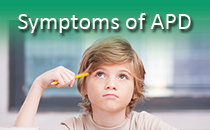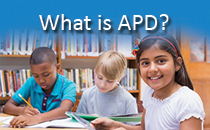Research indicates up to 70% of individuals with dyslexia have an underlying auditory processing disorder

According to the National Institutes of Health, in children referred for learning difficulties, around 43% have Auditory Processing Disorder (APD). In addition, 25% of all children tested for learning disabilities were found to have coexisting APD and dyslexia. Dyslexia and Auditory Processing Disorder share many of the same symptoms, but they are different disorders calling for separate treatment methods.
What is the difference in Auditory Processing Disorder and Dyslexia?
Dyslexia is a language-based learning disability often associated with slow or inaccurate reading, poor spelling, poor writing, or mixing up similar words. Individuals with developmental dyslexia have an abnormality in the word analysis pathways that interfere with their ability to convert written words into spoken words. Research suggests that developmental dyslexia may be too complex to be explained by just one causal factor. Theories have suggested different cognitive subtypes, and there can be multiple causal factors within each dyslexic individual. There is considerable research evidence that the core deficit in many children with developmental dyslexia is a phonological processing deficit. This contributes to difficulty understanding the way words are made up of sounds (phonemes) and how these sounds are mapped onto their written counterparts (graphemes). Phonological processing problems in individuals with dyslexia are related to 1) a weakness in phonological awareness (understanding sounds and oral language patterns within words), 2) phonological memory (holding on to speech-based information in short-term memory), and/or 3) rapid automatized naming (quickly identifying and naming a series of common stimuli such as letters, numbers, colors, or objects). This often shows up in the subtests of the reading and writing assessments.
Auditory Processing Disorder is an abnormality in the processing of sound in the central auditory nervous system. This causes a breakdown in the brain’s ability to accurately and efficiently process sounds and language. This can make it hard to distinguish small sound differences within words, remember what was heard, and keep up with ongoing speech, especially when there is background noise or when more than one person is talking. Children with APD also tend to say “what?’ or “huh” frequently even when they seem to be paying attention. Asking for repetition of what was heard does not have anything to do with reading or spelling but it is a big red flag that the child is having difficulty processing spoken language.
Dyslexia evaluations typically include intellectual and academic achievement testing. Sometimes receptive (listening) and expressive language skills may be assessed as part of a dyslexia evaluation as well. However, a dyslexia evaluation does not test children for auditory processing disorder. Dyslexia is typically diagnosed by psychologists, psychometrists, or speech-language pathologists. To rule out auditory processing disorder, a child must be evaluated by an audiologist specializing in the assessment of the central auditory nervous system. While other professionals such as psychologists, psychometrists, speech-language pathologists, or occupational therapists may suspect an individual has auditory processing weaknesses from interacting with the child or administering screening instruments, an audiologist is the only professional whose scope of practice is to evaluate the central auditory nervous system and diagnose or rule out an auditory processing disorder.
Since there are different types of APD, the prevalence found in children with dyslexia will vary depending on the specific tests used and the auditory processing skills measured. Areas of auditory processing that are most likely to show performance deficits in individuals with dyslexia include temporal/timing sequencing of information (as assessed by pitch pattern tests and tests using quick changes in sounds), auditory figure ground problems (as assessed by different speech in noise tests) and interaural asymmetry in competition (as assessed by dichotic listening tests). Other deficits may appear in some dyslexic children, but most dyslexic children, these are the primary areas where weaknesses will be found.
Overlooking an auditory processing disorder can lead to years of extra reading instruction working around an underlying problem. While many symptoms of dyslexia overlap with auditory processing disorders, children with APD tend to struggle with spelling and learning to read because they do not hear speech sounds clearly. Speech sounds are imprinted in our auditory cortex early in life. But in children with APD, something goes wrong in the central auditory nervous system, making their perception of sounds inconsistent. This leads to sound concepts that are vague, distorted, or overlap with other sounds. So, children with auditory processing disorder often have a tough time with phonological awareness (which is recognizing the sound parts that make up words) because they have incorrect sound concepts stored in their brains for the sounds of our language.
Children showing difficulties with auditory decoding should begin with auditory training. This training helps clarify and their understanding of speech sounds, as the accurate recognition of these sounds lays the essential foundation for effective reading and spelling skills. Research using brain imaging studies and auditory evoked potentials (brain wave responses to sound) has documented that impairments in the neural encoding of acoustic elements essential for distinguishing consonants, such as subtle pitch and timing differences in speech sounds, contribute to the poor consonant differentiation and phonological skills seen in children with reading difficulties. Given that auditory processing disorder affects the ability to distinguish similar-sounding sounds, it subsequently impacts a child’s ability to learn how letters represent those sounds. For instance, when the teacher says “bat,”they might hear variation like “dat,” “bap,” “gat,” “vat,” “back,” or “pat.” Consequently, when asked to spell “bat” they may write “dat.” Children with APD often struggle to consistently associate a sound with a specific letter (i.e. “b” as “buh” not “duh”) because they perceive that letter pronounced differently each time. This difficulty extends to phonological awareness activities, such as altering sounds in words. For instance, when asked to change the “mmm” sound to “nnn” in “me,” they may face challenges due to inconsistent recognition of these sounds.
It is important to consider how much success in school relies upon receiving an intact auditory message. If the earlier parts of the auditory pathways are not sending along the correct signals, the higher-level language functions can be compromised. Therefore, undiagnosed APD can lead to academic problems and limit progress in other therapies targeted at remediating language and/or reading disorders.
Treatment differs for auditory processing disorder versus dyslexia, so it is important to ensure an accurate diagnosis and identify any cooccurring conditions to facilitae obtaining the appropriate intervention. The treatment needed for auditory processing disorder will differ based on each child’s specific auditory processing deficits, which may include difficulties in filtering out background noise, remembering what was heard, and processing sound accurately and efficiently. The primary goal is to enhance the accuracy and efficiency of sound processing to improve overall auditory comprehension and language skills. Individuals with dyslexia need intensive dyslexia therapy that utilizes a multisensory Orton Gillingham based reading program that breaks the language down and teaches the reader to decode based on syllable types and spelling rules.
The comparison chart below can be useful when comparing symptoms of APD and dyslexia. If a child with dyslexia also has symptoms in the column associated with auditory processing disorder, APD testing is strongly recommended. Working around an underlying auditory processing problem can make it difficult to make good progress with dyslexia therapy.
| Auditory Processing Disorder (APD) | Dyslexia |
| Difficulty processing sound | Difficulty manipulating language either verbally and/or when reading and spelling |
| Difficulty recognizing subtle differences in sounds (i.e hearing the difference in short -i- and short -e- ) | Difficulty with phonological processing and may also have problems with larger units of sounds (i.e identifying the number of words and syllables) |
| Difficulty distinguishing between verbally presented sounds or words. May hear fees instead of flees, poor instead of pour, or pig instead of big. | Difficulty manipulating sounds in words. Change the “p” in “pig” to “b” and you get the word “big.” Remove the “l” from fleas and you get “fees“ |
| May have difficulty with spelling, reading, and understanding information presented verbally | May have difficulty with spelling, reading, and understanding information presented in print |
| May have difficulty understanding stories heard unless they are brief and have illustrations. | Good understanding of stories read aloud to them. |
| Fatigue easily when listening | Fatigue easily when reading |
| Need more time to process information heard | Difficulty processing what they read |
| Difficulty following directions orally | Difficulty following written directions |
| Spelling errors tend to be omissions or the wrong sound (i.e blump/blunt) | May spell words phonetically but far from being correct (i.e. frens/friends) |
Research shows that personal remote microphone systems such as a Roger Focus system are beneficial for both children with APD and children with dyslexia. These systems send the teacher’s voice directly to tiny earpieces worn by the child. This results in improved clarity and an immediate ease in listening. Research in children with dyslexia showed that over time remote microphone systems lead to a permanent improvement in hearing abilities and improved phonemic awareness. Since a lot of children with dyslexia have problems distinguishing similar sounding sounds, the improved clarity from bringing the talker’s voice directly to the child’s ears helps the child hear each sound distinctly. This helps the brain learn to map sounds correctly onto phonograms, which can facilitate a child’s progress in dyslexia therapy. Visit our remote microphone system page for more information.
Resources
Research indicates children with dyslexia exhibit
- Difficulty processing rapid frequency and timing characteristics of phonemes (Burns 2013) Difficulties with slow auditory sampling affecting syllable perception (Goswami 2011)
- Speech perception in noise deficits (Ziegler et al. 2009)
- Poor performance on dichotic tests (Moncrief and Black 2008; Moncrief et al. 2004)
- Poor consistency of the auditory brainstem response to speech stimuli (Hornickel et al. 2012)





